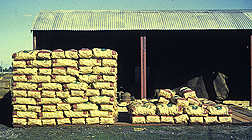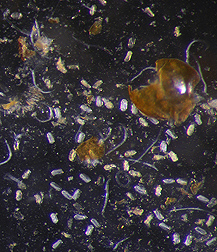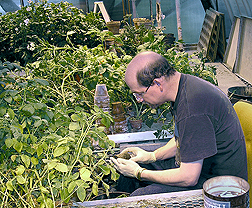Potatoes: A Tale of Two Threats
Nematode, plant virus show why
battle to protect crops is never-ending.
|
|
“Never take anything for granted” is an adage that certainly applies to sustainable agriculture.
Consider what happened with the golden nematode, Globodera rostochiensis, and potato virus Y (PVY), two especially persistent scourges of potato.
Two decades ago, existing regulations and scientific breakthroughs had seemingly brought both of these threats under control. “But two events jeopardized that,” says plant pathologist Stewart Gray of ARS’s Plant Protection Research Unit (PPRU) in Ithaca, New York.
“First, a new race, or population, of the nematode has emerged—one that attacks potato plants that resist the original race. Second, widespread acceptance and planting of potato varieties that turned out to be symptomless carriers of PVY has allowed that disease to reemerge.” PVY’s resurgence impedes efforts to identify virus-infected seed potatoes and limit their distribution.
Recent developments have been downright disheartening to people fighting the golden nematode.That’s because such significant gains had previously been made against it.
This root-infesting pest—also called the “potato cyst nematode”—is nearly impossible to rid from contaminated soil because its eggs can lie dormant, protected within the dead body of its parent, for up to 30 years.
First seen in the United States in 1941 on Long Island, the nematode was kept in check first with pesticides and later by crop rotation and planting of nematode-resistant potato varieties. These strategies have helped confine the pest to nine New York counties.
But the newer race, first identified in 1995, has added urgency to PPRU molecular biologist Xiaohong Wang’s studies on how cyst nematodes interact with their hosts. “If it were to become established in potato, tomato, and eggplant fields, it would cause significant annual losses and compromise trade,” she says.
Resistance Gene Ineffective
ARS and Cornell University researchers in Ithaca have introduced more than 30 potato varieties that resist the original nematode race. The key to this resistance is a potato gene called H1.
But Wang says that H1 has no effect on the new nematode race, which scientists have dubbed “Ro2.” “What’s lacking is a way to rapidly identify and separate the two races,” she says.
Determining race with a traditional bioassay takes almost 2 years, during which time potato growers can only hope their fields don’t contain Ro2. “If Ro2 is found, the farmer is forced to abandon potato production,” says Wang.
She’s eyeing Ro2’s eggs and genes as potential “soft spots” to exploit as part of a race-identification strategy.
Wang is using PCR (polymerase chain reaction) to amplify and study specific parts of the nematode’s DNA. “When used on nematode cysts, they’ll help us determine race in a matter of weeks, if not sooner,” she says.
Wang is also using an emerging molecular method called “RNA interference” that uses fragments of double-stranded RNA to hinder, or silence, gene expression. She says she was inspired by a recent study in which RNA interference helped attain broad resistance against four root-knot nematode species in the model plant Arabidopsis.
|
|
Virus Flexes New Muscles
Meanwhile, PVY’s reemergence has become a focus of Gray’s work. Transmitted by aphids to plants, PVY threatens not only potato, but also other crops such as tomato, pepper, and tobacco. “It spreads rapidly and can have dramatic impacts on yield and quality,” says Gray. “Insecticides generally don’t kill aphids fast enough to prevent its spread.”
Gray calls potato varieties that are symptomless carriers of PVY “Typhoid Marys.” They hamper seed-certification programs’ ability to identify virus-infected seed lots. “This and the detection of new PVY strains that cause a more severe disease in potato and tobacco are major reasons the reemergence presents such a serious problem,” says Gray.
“The once-distinct PVY strain groupings are becoming blurred because of genetic recombination and mutation in the virus,” he adds.
Gray has helped develop and implement the Canada/U.S. Management Plan for Potato Viruses That Cause Tuber Necrosis.
“PVY is a principal focus of this bi-national plan, which is aimed at managing these diseases at levels well below any economic threshold so as to allow continued trade of seed potatoes within and between the two countries,” he says.
Part of the plan is a 3-year effort being coordinated by Gray to survey all U.S. potato seed-production areas and determine the genetic diversity and distribution of PVY strains. Taking part are ARS, university scientists from Idaho and New York, and the seed-certification agencies in all 16 seed-producing states.
“Excluded” Strains Are Here
“Surveys so far show that although the common PVY strain is still the most prevalent, others once thought to be excluded from the United States are present here and in Canada,” says Gray. “The genetic diversity of PVY also seems to differ among geographical areas.
“The goal now is to limit virus incidence and prevent the tuber necrotic strains from becoming predominant, as they have in Europe.”
Also, the new strains are more efficient at infecting tubers of some potato varieties. “We need to know whether this is due to increased ability to infect a higher proportion of tubers or to more efficient transmission by aphids,” he says.
Either way, PVY management strategies will be affected. “We must consider that a uniformly applied prevention or control policy may not be effective,” says Gray. “Instead, regional approaches may be more appropriate.”
PPRU research leader Donna Gibson says that these studies underscore a wider focus at Ithaca toward gaining a better understanding of genetic and environmental factors driving nematode and virus disease dynamics. “Ultimately,” she says, “rapid identification and containment of nematodes and virus diseases will help the potato industry remain viable and allow for expansion of market share.”
Gibson was involved in landmark potato research herself. She and Cornell collaborators discovered a key enzyme involved in producing a toxic metabolite that causes the symptoms of potato scab. This disease usually doesn’t affect yields, but it makes tubers unsightly and difficult to market.—By Luis Pons, formerly with ARS.
This research is part of Agricultural System Competitiveness and Sustainability (#216) and Crop Protection and Quarantine (#304), two ARS national programs described on the World Wide Web at www.nps.ars.usda.gov.
Stewart Gray, Xiaohong Wang, and Donna Gibson are in the USDA-ARS Plant Protection Research Unit, Cornell University, Tower Rd., Ithaca, NY 14853-2901; phone (607) 255-7844 [Gray], (607) 255-3518 [Wang], and (607) 255-2359 [Gibson], fax (607) 255-1132.
"Potatoes: A Tale of Two Threats" was published in the August 2007 issue of Agricultural Research magazine.











